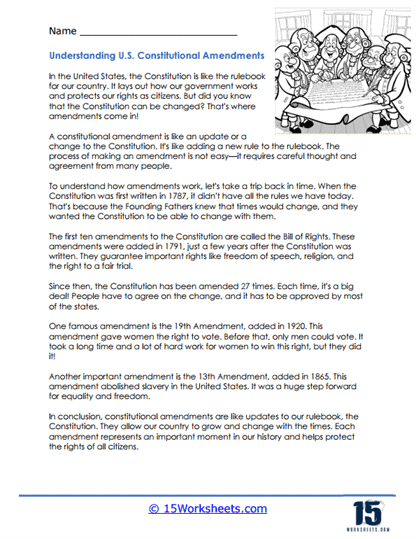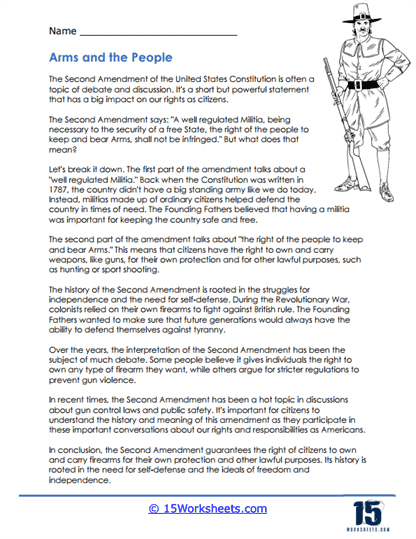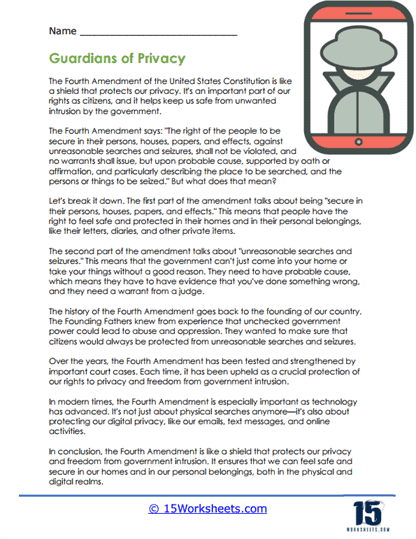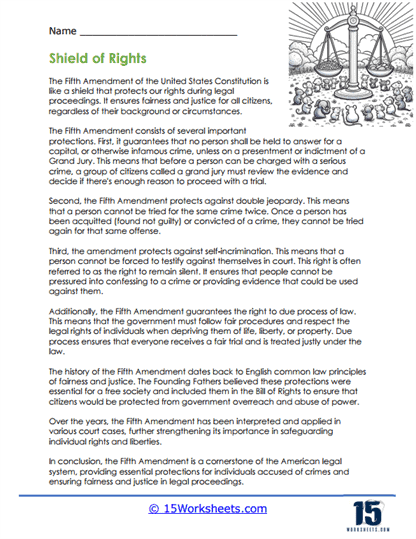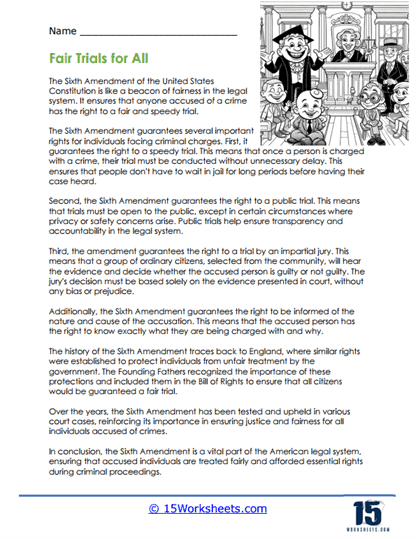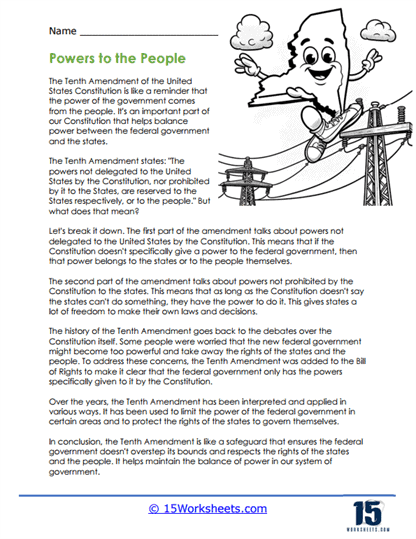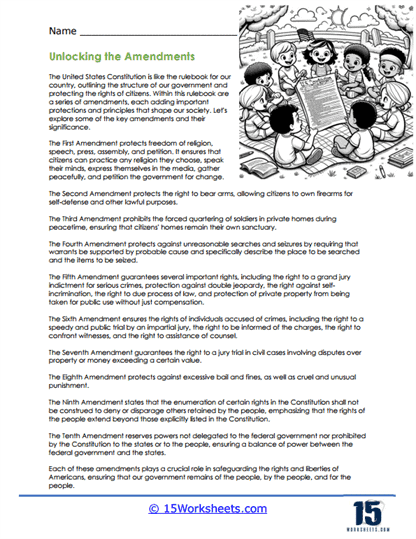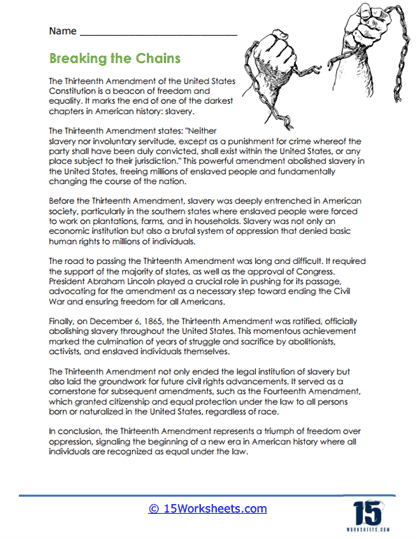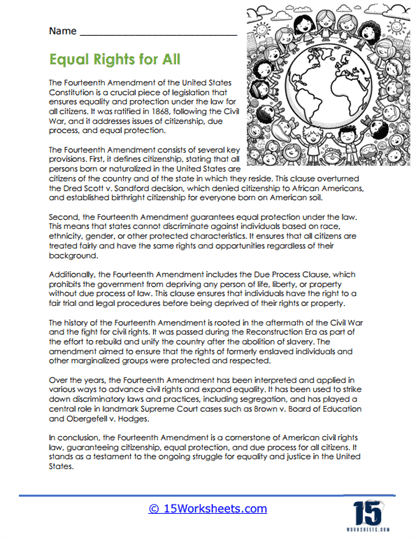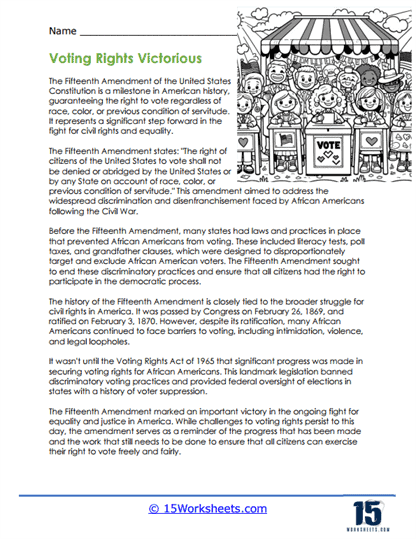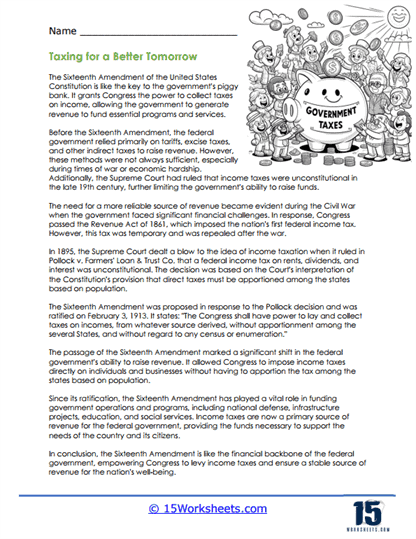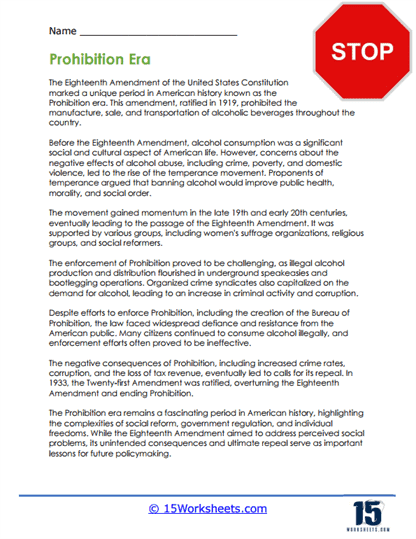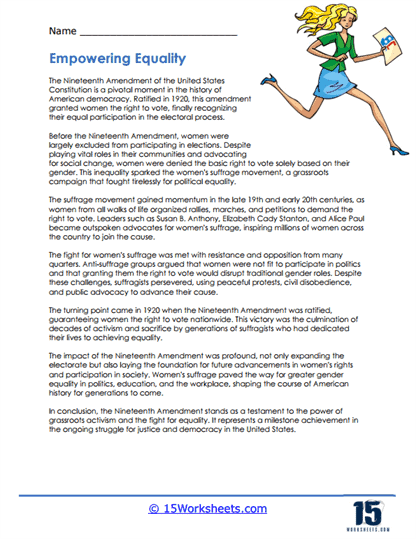Constitutional Amendments Worksheets
About These 15 Worksheets
These worksheets will enhance student knowledge and understanding of the United States Constitution, particularly the amendments that have been ratified since its inception. These amendments form the backbone of American law and civil rights, representing the dynamic and evolving nature of the nation’s legal framework. The worksheets vary in format and complexity, tailored to suit a range of educational levels from elementary to high school, and even college courses in political science or pre-law.
They not only assist in learning the letter of the law but also support critical engagement with the spirit of the law, ensuring students develop into well-rounded individuals equipped to participate fully and knowledgeably in the democratic process. These types of worksheets typically include several exercises designed to engage students with the content and context of each amendment. Here are various types of exercises one might find on these worksheets:
Type of Exercise on These Worksheets
Matching Exercises – In matching exercises, students are typically presented with two columns — one listing the numbers or titles of the amendments and the other listing various summaries or key points that describe the amendments’ main purposes. The task is for students to draw lines or otherwise connect each amendment to its corresponding summary. This activity not only reinforces recognition of each amendment but also encourages students to make associations between the language of the amendments and their practical effects on citizens’ rights and government structure.
Fill-in-the-Blanks – Fill-in-the-blank exercises present students with partial excerpts from the amendments, where key terms or phrases are omitted. Students must use their memory and understanding of the amendments to complete the text accurately. This exercise reinforces knowledge of the exact wording, which is crucial since legal language is precise, and every word can hold significant judicial weight.
Multiple-Choice Questions – These questions present students with a statement about an amendment and several possible answers. Students must select the correct option that best aligns with the amendment’s true applications or historical implications. This exercise tests both the breadth and depth of students’ knowledge, challenging them to consider how the amendments have been interpreted and applied over time.
True or False Quizzes – True or false quizzes consist of a series of statements about the amendments, and students must determine whether these statements are accurate. This form of exercise pushes students to critically assess their understanding of the amendments and debunk common misconceptions, which is crucial for developing a nuanced understanding of constitutional rights and governance.
Short Answer Questions – These questions require a written response that typically consists of a few sentences. Students must use their own knowledge to explain aspects of an amendment, such as its significance or impact. Short answer questions challenge students to communicate their understanding clearly and succinctly, reinforcing their grasp of the material and their ability to express it.
Essay Prompts – Essay prompts on Constitutional Amendments Worksheets offer a more complex challenge, requiring in-depth responses that typically cover several paragraphs. Students might be asked to discuss why an amendment was introduced, its effects on the legal system and society, or how it has been relevant to particular historical events. These prompts enhance critical thinking, research skills, and the ability to construct coherent, persuasive arguments.
Case Study Analyses – When students engage with case studies related to specific amendments, they are asked to examine the facts of the case, the legal questions at stake, and the judicial reasoning used to apply the amendment in question. This exercise helps students understand the living nature of the Constitution, how it guides judicial interpretation, and the impact of precedent on current law.
Discussion Questions – These prompts are designed to spark conversation and reflection among students. By discussing the amendments and their contemporary implications, students develop a more dynamic understanding of how these laws apply to current societal issues and contribute to the living dialogue that surrounds constitutional interpretation.
Timeline Activities – Timeline activities require students to place significant events in chronological order, offering a visual representation of how the amendments came to be. This helps students connect historical movements, such as suffrage or civil rights, with the legal milestones that codified these shifts in the national consciousness and law.
Graphic Organizers – Graphic organizers might involve students creating visual aids that connect different amendments or parts of an amendment with their effects on the law, society, and individual rights. These visual tools can help students to see relationships between concepts, facilitate memory retention, and synthesize complex information in a more digestible form.
Summary Writing – In summary writing exercises, students must succinctly restate the essence of an amendment, often in a limited number of words. This process requires a deep understanding of the content, as students must decide what is most crucial about the amendment and how to express its core principles and impacts effectively.
Application Exercises – Application exercises present scenarios – either historical or hypothetical – that students must analyze through the lens of specific amendments. They require students to think critically about how the Constitution applies to real-world situations, deepening their ability to interpret the document and understand its practical implications for governance and individual rights.
The Benefits of These Worksheets
Practicing with these worksheets can significantly improve students’ understanding of democracy and the U.S. Constitution. Here’s how:
Building Fundamental Knowledge – Regular practice with Constitutional Amendments Worksheets ingrains the text of the amendments in the students’ memory, establishing a solid base for all further study of American governance and law. This memorization is not about rote learning; rather, it provides a framework upon which students can build more complex ideas, such as interpreting the legal language and understanding the broader implications for civil society. By having the content of the amendments at their fingertips, students are better prepared to engage in informed discussions and make connections between different aspects of law and governance.
Enhancing Critical Thinking – The analytical exercises in these worksheets challenge students to go beyond surface-level understanding and deeply analyze the meanings and consequences of the constitutional amendments. By contemplating the broad implications of these amendments, students learn to evaluate how these fundamental changes have sculpted American society and its legal system. Such critical analysis develops reasoning skills that are applicable beyond the study of the Constitution and into other areas of academics and civic life.
Developing Civic Awareness – A deep understanding of the amendments is vital for students to function as informed citizens within a democracy. These worksheets bring to light how the Constitution affects governance, protects individual rights, and outlines the civic duties of Americans. As students recognize the relevance of the Constitution in daily life—from freedom of speech to the right to a fair trial—they become more motivated to participate in civic activities and uphold democratic values.
Encouraging Historical Perspective – Worksheets that provide historical context for the amendments help students understand that these laws were responses to real-world issues and reflect the values and challenges of their times. As students learn about the events and movements that necessitated each amendment, they develop a connection to the past and recognize the Constitution as a living document, evolving with society’s changing needs. This historical perspective is crucial in appreciating the enduring nature of the Constitution and the ongoing effort to ensure justice and liberty.
Improving Legal Literacy – Engaging with case studies and real-world applications of constitutional amendments, students learn to interpret legal language and understand how abstract principles are applied in concrete situations. This enhanced legal literacy makes students more adept at identifying how laws influence various aspects of life, including issues of public policy and individual rights. It also prepares them for potential future studies in law, politics, or public administration.
Promoting Discussion and Debate – By taking part in discussions and debates through worksheet activities, students learn to express their ideas and to listen and respond to others’ opinions. These exchanges promote a democratic ethos in the classroom, where every voice is heard, and diverse viewpoints are valued. Such dialogues prepare students for participation in the larger discussions that shape society and policy, embodying the democratic principle of informed debate.
Fostering Empathy and Ethical Reasoning – Through role-playing scenarios and case study analyses, students are encouraged to empathize with the people affected by the amendments. They consider the impact of these laws on individuals’ lives, which can deepen their understanding of the amendments’ significance and foster a sense of justice and fairness. This empathy is the foundation of ethical reasoning, as students learn to weigh the consequences of legal decisions and policies on human lives.
Aiding in the Development of Communication Skills – Effective communication is essential in almost all aspects of life, and worksheets help to develop this skill set. Essay writing and summarization tasks require students to organize their thoughts and convey complex constitutional concepts in a clear and concise manner. These exercises build the students’ ability to argue persuasively, explain legal concepts to non-experts, and engage in intelligent discourse on complex topics.
Strengthening Analytical Writing – The process of writing about the amendments forces students to structure their thoughts, present evidence, and build cogent arguments. These skills are crucial for academic success across disciplines and in future careers where the ability to synthesize information, provide analysis, and articulate findings is invaluable. As students refine their writing, they are also learning to think more deeply about the content, formulating their own interpretations and criticisms of the law.
What Are Constitutional Amendments?
The U.S. Constitution is the foundational legal document that outlines the structure, functions, and powers of the federal government, as well as the relationship between the federal government and the states, and the rights of the individual states. It was drafted in 1787 and ratified in 1788. The Constitution establishes the framework for the entire U.S. system of government, including the creation of Congress, the presidency, and the Supreme Court. It also articulates the principles of federalism, the separation of powers, and checks and balances that are designed to prevent any one branch or level of government from gaining too much power.
An amendment to the U.S. Constitution, on the other hand, is a change or addition to the Constitution. The Framers of the Constitution understood that over time, the nation might need to make adjustments to the original document, so they included a process for making amendments in Article V of the Constitution. Amendments are proposed changes that must be ratified by a supermajority of the states before becoming a part of the Constitution. Once ratified, an amendment becomes as much a part of the Constitution as any of the original articles.
The difference between the Constitution and its amendments lies in their scope and function. The Constitution itself sets up the system, while amendments adjust, clarify, expand, or restrict that system. They are ways to address issues that arise or to reflect the evolving values and beliefs of the nation. Importantly, amendments can also serve to protect individual rights and liberties against infringement by the government, sometimes adding specific protections that were not explicitly stated in the original text.
Two examples of Constitutional Amendments are:
Example #1 – The First Amendment
Ratified in 1791 as part of the Bill of Rights, the First Amendment protects several fundamental freedoms within a single statement. It ensures freedom of religion (prohibiting Congress from establishing a religion and protecting the right to free exercise of religion), freedom of speech, freedom of the press, the right to assemble peacefully, and the right to petition the government for a redress of grievances. This amendment is central to the American value of free expression and is one of the most cited and referenced in legal cases, political debates, and cultural discussions.
Example #2 – The Fourteenth Amendment
Adopted in 1868, in the aftermath of the Civil War, the Fourteenth Amendment is one of the Reconstruction Amendments. It contains several important principles. Its first section introduces the Citizenship Clause, granting citizenship to all persons born or naturalized in the United States, which overruled the Dred Scott v. Sandford (1857) decision that had said African Americans were not citizens. It also contains the Equal Protection Clause, which requires states to provide equal protection under the law to all people within their jurisdictions. Additionally, it has the Due Process Clause, which guarantees that states cannot deny anyone “life, liberty, or property” without due process of law. This amendment has been foundational in many significant Supreme Court cases dealing with civil rights, including Brown v. Board of Education, which declared racial segregation in public schools unconstitutional.
These amendments, like all others in the Constitution, are significant because they have clarified, expanded, or limited the principles laid out in the original text, reflecting the changing norms and values of American society and its ongoing struggle to live up to the ideals of liberty and justice for all.

